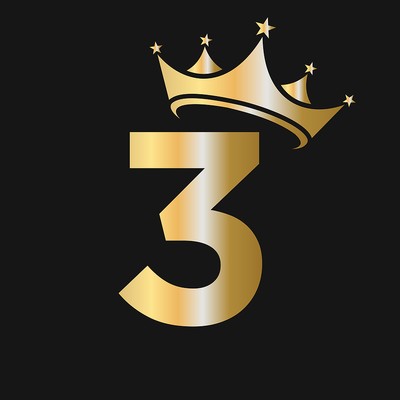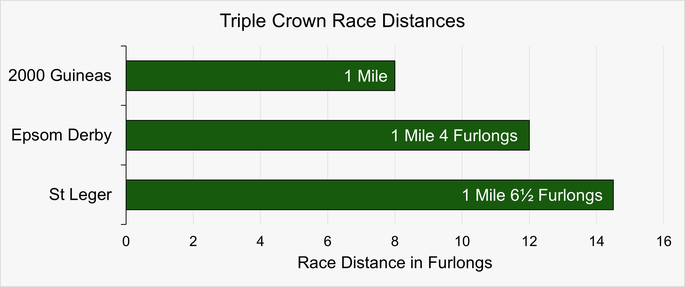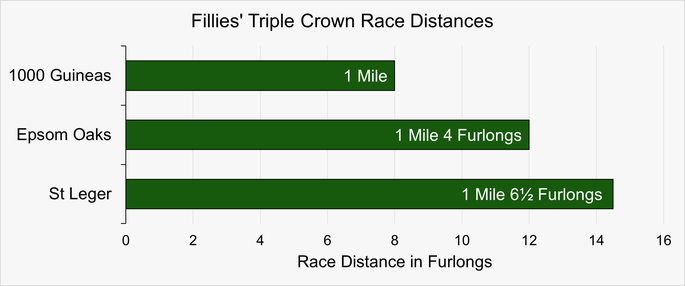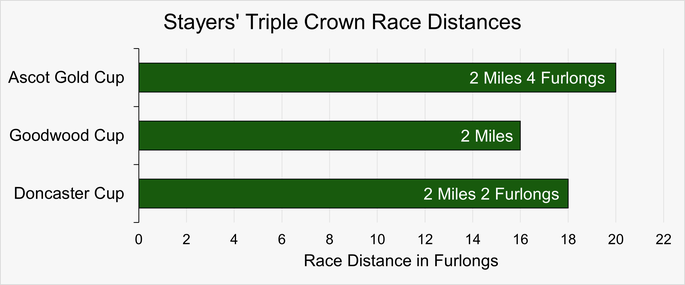 When it comes to accomplishments in the world of horse racing, each discipline has their own levels. In jump racing, for example, races like the Grand National and the Cheltenham Gold Cup will always stand out as being the ones that owners, jockeys and trainers alike are all keen to be on the winner’s podium for. When it comes to flat racing, meanwhile, the desire for those in the industry will always be to win one of the Classics. Of course, it is possible for horses to win more than one of the Classics, with the only limitation on doing so being the gender requirements for the race.
When it comes to accomplishments in the world of horse racing, each discipline has their own levels. In jump racing, for example, races like the Grand National and the Cheltenham Gold Cup will always stand out as being the ones that owners, jockeys and trainers alike are all keen to be on the winner’s podium for. When it comes to flat racing, meanwhile, the desire for those in the industry will always be to win one of the Classics. Of course, it is possible for horses to win more than one of the Classics, with the only limitation on doing so being the gender requirements for the race.
In the United Kingdom, three of the five Classic races are open to colts and fillies. These are the 2,000 Guineas, the Derby and the St Leger Stakes. This is known as the Triple Crown of thoroughbred racing, with horses that have won all three events in the same season said to have completed the Triple Crown. There is also the Fillies’ Triple Crown, which is for winners of the 1,000 Guineas, the Epsom Oaks and the St Leger Stakes, as well as the Stayers’ Triple Crown. The latter is for winners of the Ascot Gold Cup, Goodwood Cup and Doncaster Cup.
Quick Answer: How Many Horses Have Won the Triple Crown of UK Flat Horse Racing?
Between 1809 and 2023, twelve horses have won the official Triple Crown of winning the 2000 Guineas at Newmarket, the Derby at Epsom and the St Leger at Doncaster. The first was West Australian in 1853 and the Latest was Nijinsky in 1970.
In addition to this, three horses have won the unofficial Triple Crown when all three races were held at Newmarket during the First World War. They were Pommern in 1915, Gay Crusader in 1917 and Gainsborough in 1918.
There have been nine winner of the Fillies’ Triple Crown of the 1000 Guineas, Epsom Oaks and the St Leger. The latest winner of this was Oh So Sharp in 1985 for the late trainer Sir Henry Cecil.
The Stayers’ Triple Crown doesn’t include any Classic races, consisting of the Ascot Gold Cup, Goodwood Cup and the Doncaster Cup. This has been won on eight occasions – twice by Le Moss in 1979 and 1980, and most recently by Stradivarius in 2019.
The Triple Crown Explained

The 2,000 Guineas was first run on the 18th of April in 1809. It was created by the Jockey Club under the direction of Sir Charles Bunbury, who had earlier been a co-founded of the Derby at Epsom. In spite of being formed earlier, we will tell you about the Derby in more detail shortly as it comes later in the season and horses therefore need to have won the 2,000 Guineas in order to have a hope of winning the Triple Crown. The race was named after the prize money associated with it, with the connections of the winning horse taking home 2,000 Guineas for their success.
In the years that followed it became one of the most prestigious races in the country, with alternatives to it popping up all around Europe. Nowadays, events like the Craven Stakes and Greenham Stakes serve as good trials for the 2,000 Guineas, whilst the 2,000 Guineas acts as something of a trial for the Derby. Jem Robinson won the race nine times during his career as jockey. It is run over one mile on the straight and is open to horses aged three, with geldings being excluded. In that sense, it is similar to the Epsom Derby, which was first run in 1780.
The Derby came after the Oaks, which was first run in 1779 and limited to fillies, so it was felt that a similar race that colts could run in should be organised. Legend has it that the name of the race was either going to be in honour of the 12th Earl of Derby or Sir Charles Bunbury, decided by the toss of a coin. It is much more likely that Bunbury deferred to his host, but got the last laugh when a horse that he owned, Diomed, won the inaugural running of the race. Run over one mile, four furlongs and ten yards, it is now Britain’s richest flat race and is for three-year-old colts and fillies.
As with the 2,000 Guineas, there are numerous races run around Europe that are variations of the Derby. It has a maximum field of 20 runners and in 1931 became the first outdoor sporting event in the world to be televised. It is the middle leg of the Triple Crown, with the St Leger Stakes coming after it. That is also a race that is open to colts and fillies, excluding geldings, being for three-year-olds and run over one mile, six furlongs and 115 yards. It was created by Anthony St Leger, a politician and army officer who lived near Doncaster, where the event is held.
Established in 1776, it is the oldest of the Classics but the last of the Triple Crown events to be run in order. Originally referred to as a ‘sweepstake of 25 Guineas’ because that was the prize money on offer, it was run over two miles and the rules said that colts and geldings needed to carry eight stone, with fillies carrying two pound less. A dinner party was held at the Red Lion Inn in Doncaster in 1778 to decide upon the race’s name, with the initial idea being that it be called the Rockingham Stakes in honour of the host, the Marquess of Rockingham. He refused, however, saying that it should be named after the race’s creator.
The race’s length was cut down to one mile, six furlongs and 193 yards in 1813, with only minor alterations to that taking place since. In 1906 the decision was made to close it to geldings. As with the other two races that make up the Triple Crown of thoroughbred racing, there are numerous races run across Europe that are themed after it. No jockey has won the race more times than the nine wins managed by Bill Scott between 1821 and 1846, but that pales in comparison to the 16 wins that his brother John Scott managed as trainer between 1827 and 1862.
Winners of the Triple Crown
At the time of writing, 15 horses have managed to win the Triple Crown of Racing, 12 official and 3 unofficial. Here is a look at the horses that have pulled it off:
Triple Crown Winners – 1809 to 2023
| Horse | Year | Jockey(s) | Trainer |
|---|---|---|---|
| West Australian | 1853 | Frank Butler | John Scott |
| Gladiateur | 1865 | Harry Grimshaw | Tom Jennings, Sr. |
| Lord Lyon | 1866 | Harry Custance | James Dover |
| Ormonde | 1886 | Fred Arche & George Barrett | John Porter |
| Common | 1891 | George Barrett | John Porter |
| Isinglass | 1893 | Tommy Loates | James Jewitt |
| Galtee More | 1897 | Charles Wood | Sam Darling |
| Flying Fox | 1899 | Morny Cannon | John Porter |
| Diamond Jubilee | 1900 | Herbert Jones | Richard Marsh |
| Rock Sand | 1903 | Danny Maher | George Blackwell |
| Pommern* | 1915 | Steve Donoghue | Charles Peck |
| Gay Crusader* | 1917 | Steve Donoghue | Alec Taylor, Jr. |
| Gainsborough* | 1918 | Joe Childs | Alec Taylor, Jr. |
| Bahram | 1935 | Freddie Fox & Charles Smirke | Frank Butters |
| Nijinsky | 1970 | Lester Piggott | Vincent O’Brien |
*Pommern, Gay Crusader and Gainsborough all won the Triple Crown during the war, with many believing that these don’t count as real Triple Crown wins. Aside from the fact that racing itself was hugely disrupted, all of the events were held at Newmarket as opposed to across different racecourses as would normally be the case.
Horses That Came Close but Missed Out
As you might imagine, the need to win three competitive races has proven to be too much for some horses over the course of a season. As a result, there are a number of horses that managed to win the first two of the three events but missed out. Here is a look at the horses in question, who won the 2,000 Guineas and the Derby but didn’t manage to win the St Leger in order to complete their Triple Crown attempt:
Winners of the 2000 Guineas & Derby in the St Leger
| Horse | Year | 2000 Guineas | Epsom Derby | St Leger |
|---|---|---|---|---|
| Cotherstone | 1843 | 1st | 1st | 2nd (to Nutwith) |
| Pretender | 1869 | 1st | 1st | 4th (to Pero Gomez) |
| Shotover | 1882 | 1st | 1st | 3rd (to Dutch Oven) |
| Ayrshire | 1888 | 1st | 1st | 6th (to Seabreeze) |
| Ladas | 1894 | 1st | 1st | 2nd (to Throstle) |
| St. Amant | 1904 | 1st | 1st | 7th and last (to Pretty Polly) |
| Minoru | 1909 | 1st | 1st | 4th (to Bayardo) |
| Manna | 1925 | 1st | 1st | 10th (to Solario) |
| Cameronian | 1931 | 1st | 1st | 10th (to Sandwich) |
| Camelot | 2012 | 1st | 1st | 2nd (to Encke) |
In addition to those ten horses, Blue Peter can also consider himself to be extremely unlucky. Having won the 2,000 Guineas and the Derby in 1939, he never got the chance to win the St Leger because horse racing was cancelled after the outbreak of the Second World War.
Fillies’ Triple Crown

When it comes to flat racing, there are two races that are limited to fillies, meaning that colts are unable to win the race. As a result, there is another category that is the Fillies’ Triple Crown, giving just female horses the opportunity to win it. The first race in the Fillies’ Triple Crown is the 1,000 Guineas, which was first run on the 28th of April in 1814, coming along five years after the 2,000 Guineas was run for the first time. It was another race created by Sir Charles Bunbury of the Jockey Club, with the name also being given as a result of the prize money available to the winner.
By the time the 1860s came about, the 1,000 Guineas was considered to be one of the most prestigious races for three-year-olds run anywhere in Britain. It joined four other races in being classified as the Classics, with the gender restriction being the only reason male horses couldn’t win all five of them. Unsurprisingly, given what we know about the 2,000 Guineas, the Derby and the St Leger, the race was soon copied across Europe. In the modern era, races like the Nell Gwyn Stakes and the Fred Darling Stakes are trials for the race, but for a lot of horses it is their first event of the season.
Despite being created before the 1,000 Guineas, the Epsom Oaks comes after it in the racing calendar. It was first run in 1779 and is second only to the St Leger in terms of the age of the Classics. It was named in honour of The Oaks, which is an estate to the east of Epsom that had been leased to the 12th Earl of Derby in the 18th century. He came up with the race with some guests during a party at the estate a year before it was run for the first time, with the winner of the inaugural race, Bridget, actually being owned by the Earl himself in appropriate fashion.
It went on to become one of Europe’s most distinguished races, soon referred to as a Classic alongside some of thoroughbred racing’s other top-class events. Again unsurprisingly, different versions of the race took place across Europe and the rest of the world. Run over one mile, four furlongs and six yards, horses have carried nine stone since 1892, with numerous fluctuations on that amount occurring in the years that preceded that change. It was known as the New Oaks Stakes during both World Wars when it took place at Newmarket instead of its normal home of Epsom.
The third race to make up the Fillies’ Triple Crown is also the only one that crosses over with the Triple Crown, being the St Leger Stakes. As we’ve already given you details about that we won’t repeat ourselves here. Instead, here is a look at the horses that have managed to win the Fillies’ Triple Crown over the years:
Fillies’ Triple Crown Winners – 1814 to 2023
| Horse | Year | Jockey | Trainer |
|---|---|---|---|
| Formosa | 1868 | George Fordham & Tom Chaloner | Henry Woolcott |
| Hannah | 1871 | Charlie Maidment | Joseph Hayhoe |
| Apology | 1874 | John Osborne Jr. | William Osborne |
| La Fleche | 1892 | George Barrett & John Watts | John Porter |
| Sceptre | 1902 | Herbert Randall & Frank Hardy | Bob Sievier |
| Pretty Polly | 1904 | William Lane | Peter Gilpin |
| Sun Chariot | 1942 | Gordon Richards | Fred Darling |
| Meld | 1955 | Harry Carr | Cecil Boyd-Rochfort |
| Oh So Sharp | 1985 | Steve Cauthen | Henry Cecil |
In addition to the races in the table above, Formosa also dead-heated in the 2,000 Guineas, both Apology and La Fleche won the Ascot Gold Cup in the year of their Fillies’ Triple Crown success and Sceptre added the 2,000 Guineas to her Fillies’ Triple Crown success, making her arguably the most successful of all these horses.
Interestingly, the Fillies’ Triple Crown was not really considered to be a true Triple Crown in the past. That is because the best fillies would often be saved to run in the 2,000 Guineas and the Epsom Derby rather than the 1,000 Guineas and the Epsom Oaks. The fact that that is no longer the case means that it is retrospectively considered to be a true Triple Crown. Whether you think that is fair or not will obviously depend on your own interpretation of the importance of the races. It probably means that Oh So Sharp, the most recent winner of the Fillies’ Triple Crown, is the ‘true’ winner of it.
Stayers’ Triple Crown

Whilst the main Triple Crown will always be the ‘real’ one in the eyes of many, it is only fair to point out that there is also a series of races that are considered to be the Stayers’ Triple Crown. This is because horses that run in longer races are unlikely to feature in the 2,000 Guineas, the Epsom Derby and the St Leger, so they would never really stand a chance of winning that Triple Crown. It is also interesting to note that there have been more ‘modern’ winners of the Stayers’ Triple Crown, with most ‘normal’ Triple Crown winners tending to come from the 19th century.
The Stayers’ Triple Crown is made up of three races that are aimed at stayers, as you might imagine. These are the most prestigious of long-distance events that take place during the British flat racing season, being the Ascot Gold Cup, the Goodwood Cup and the Doncaster Cup. The first of those races enjoyed its inaugural run in 1807, with the first winner, Master Jackey, receiving 100 guineas. That race took place in front of King George III and Queen Charlotte, whilst the 1844 running saw the attendance of Nicholas I of Russia, who donated a new trophy for the winner.
That trophy was given because the horse that won the event in 1844 was unnamed at the time, so it was decided to name it ‘Emperor’ in his honour. The race was also known as the Emperor’s Plate until the outbreak of the Crimean War in 1853, when it was seen as inappropriate owning to Russia being at War with an alliance of France, the United Kingdom and Sardinia-Piedmont. At that point, the race’s original name was restored and it has been run as the Ascot Gold Cup since. Though it is the first race in the calendar, it isn’t the first race in terms of inauguration.
That honour goes to the Goodwood Cup, which was first established in 1808 and saw Bucephalus won it three times. At that point, the trophy, which was a silver cup, was awarded to the horse permanently and a new gold cup was brought in as the trophy. That was in 1812, which is considered to be the first running of the race in its current form. It is run over two miles on a left-handed track, being open to three-year-olds and over that carry certain amounts of weight depending on their age and their gender. It was a Group 2 race when grading was introduced, being downgraded to Group 3, back to Group 2 and then eventually Group 1 in 2017.
Being one of the leading races for stayers in the United Kingdom, the Goodwood Cup is the second-leg of the Stayers’ Triple Crown. It comes in the middle, with the Doncaster Cup being the final one, even though it was established first. It took place for the first time in 1766, when it was known as the Doncaster Gold Cup. It is the oldest race run at Doncaster Racecourse, pre-dating the St Leger Stakes by a decade. Initially held at Cantley Common, it moved to its current location in 1776. During its early years it really was a stayers’ event, being competed over four miles.
In 1825 it was shortened to two miles and five furlongs, being shortened again to two miles and two furlongs in 1891. In 1908 it was then shortened by another furlong, but was restored to its previous length in 1927. When the current grading was brought in, the final leg of the Stayers’ Triple Crown was given a class of Group 3, but it was promoted to Group 2 in 2003. As well as potentially winning the Stayers’ Triple Crown, winners also gain entry into the Melbourne Cup without needing to enter the ballot for the race, being the only British race where that is the case.
Here is a look at the horses that have managed to win all three of the races that make up the Stayers’ Triple Crown:
Stayers’ Triple Crown Winners – 1812 to 2023
| Horse | Year | Jockey | Trainer |
| Isonomy | 1879 | Tom Cannon | John Porter |
| Alycidon | 1949 | Doug Smith | Walter Earl |
| Souepi | 1953 | Charlie Elliott | George Digby |
| Le Moss | 1979 | Lester Piggott & Joe Mercer | Henry Cecil |
| Le Moss | 1980 | Joe Mercer | Henry Cecil |
| Longboat | 1986 | Willie Carson | Dick Hern |
| Double Trigger | 1995 | Jason Weaver | Mark Johnston |
| Stradivarius | 2019 | Frankie Dettori | John Gosden |
There are two interesting things to note about that list. Firstly, the fact that the three races that make up the Stayers’ Triple Crown are all open to horses aged older than three-years-old means that the Stayers’ Triple Crown can be won more than once, with Le Moss managing exactly that in 1979 and then again in 1980. The other interesting point is that John Porter won it as a trainer in 1879, meaning that he won both the traditional Triple Crown of thoroughbred racing, which he managed a record three times, as well as the Stayers’ Triple Crown; an impressive achievement.
